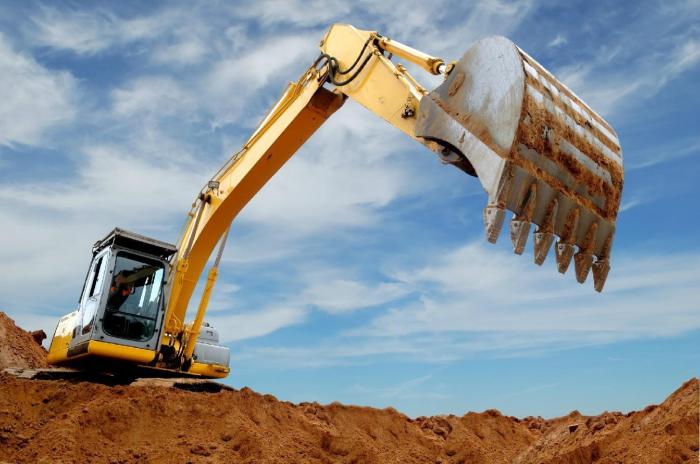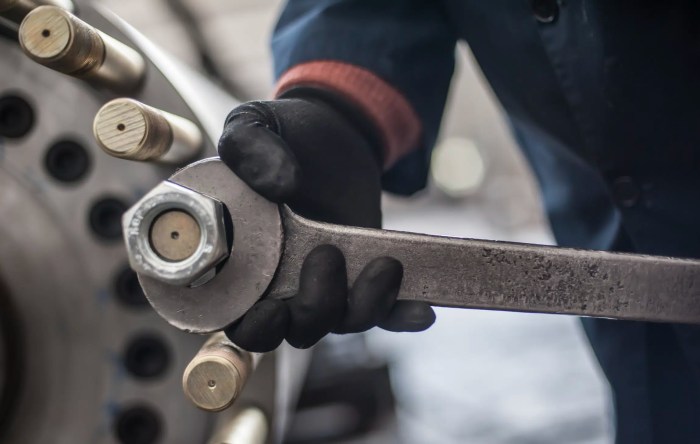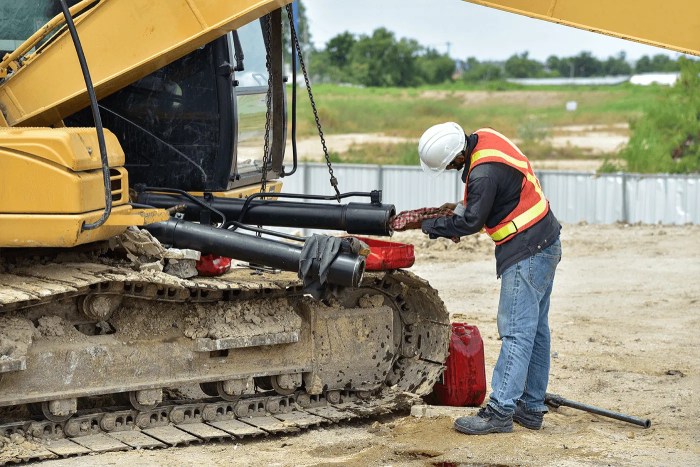Construction equipment maintenance tips take the spotlight as we delve into the importance of regular upkeep, essential tasks, best practices, and troubleshooting common issues. Discover how proper maintenance can enhance efficiency and safety in your construction projects.
Explore the checklist of routine maintenance tasks, the significance of detailed records, scheduling tips to prevent downtime, following manufacturer guidelines, proper storage practices, and the role of operator training in equipment maintenance.
Importance of Construction Equipment Maintenance
Regular maintenance of construction equipment is crucial for ensuring longevity and maximizing efficiency on the job site. Neglecting maintenance can lead to costly repairs, downtime, and even safety hazards for workers. By investing in proper maintenance, companies can save money in the long run and keep their fleet running smoothly.
Costly Repairs Due to Neglect
Maintenance issues such as worn-out parts, engine malfunctions, or hydraulic system failures can result in expensive repairs that could have been prevented with routine check-ups and servicing. Ignoring small issues can snowball into major problems that require extensive and costly repairs, impacting both the budget and project timelines.
Efficiency and Safety Benefits
A well-maintained fleet of construction equipment operates more efficiently, reducing the risk of unexpected breakdowns and delays. Regular maintenance ensures that all machinery is in optimal condition, improving productivity and keeping projects on track. Additionally, proper maintenance enhances safety on the job site by reducing the chances of equipment failures that could endanger workers.
Essential Maintenance Tasks

Regular maintenance is crucial for keeping construction equipment running smoothly and preventing costly breakdowns. Here are some essential maintenance tasks to include in your routine maintenance schedule:
Check Fluid Levels
- Regularly check and top up engine oil, hydraulic fluid, coolant, and other essential fluids to ensure proper lubrication and cooling.
- Monitor for any leaks that may indicate a more serious issue.
Inspect Filters
- Replace air, fuel, and hydraulic filters as recommended by the manufacturer to prevent contaminants from entering the system.
- Clean or replace filters more frequently in dusty or dirty work environments.
Grease Moving Parts
- Apply grease to pivot points, joints, and other moving parts to reduce friction and wear.
- Follow the manufacturer’s guidelines for greasing intervals and amounts.
Check Wear Parts
- Regularly inspect and replace worn-out teeth, cutting edges, tracks, and other wear parts to maintain equipment performance and safety.
- Monitor wear patterns to identify any underlying issues that may need attention.
Inspect Electrical System, Construction equipment maintenance tips
- Check the battery, wiring, and electrical components for signs of wear, corrosion, or damage.
- Test the charging system and replace batteries as needed to prevent unexpected downtime.
Keep Detailed Maintenance Records
Maintaining accurate records of all maintenance tasks performed, including dates, parts replaced, and any issues found, is essential for tracking the health of your equipment. These records can help identify patterns, predict future maintenance needs, and provide documentation for warranty claims or resale.
Schedule Maintenance Regularly
Creating a proactive maintenance schedule based on usage, manufacturer recommendations, and equipment condition can help prevent downtime and extend the lifespan of your construction equipment. By scheduling routine maintenance tasks in advance, you can address potential issues before they become major problems.
Best Practices for Maintenance Procedures

Proper maintenance procedures are essential to ensure the longevity and efficiency of construction equipment. By following best practices, you can prevent costly repairs, downtime, and accidents on the job site.
Importance of Following Manufacturer Guidelines for Maintenance
Manufacturers provide specific guidelines for the maintenance of their equipment for a reason. These guidelines are designed to optimize the performance and safety of the machinery. It is crucial to adhere to these recommendations to avoid damaging the equipment and ensure its proper functioning.
- Regularly scheduled maintenance tasks Artikeld by the manufacturer should be followed diligently.
- Use only recommended replacement parts and fluids to maintain the integrity of the equipment.
- Keep detailed records of all maintenance activities to track the equipment’s condition and performance over time.
- Consult the manufacturer’s manual for troubleshooting tips and guidance on common maintenance issues.
Tips on Proper Storage Practices to Extend Equipment Lifespan
Proper storage practices can significantly impact the lifespan of construction equipment. By storing equipment correctly, you can prevent corrosion, damage, and premature wear and tear.
- Store equipment in a clean, dry, and well-ventilated area to prevent rust and corrosion.
- Cover equipment when not in use to protect it from dust, debris, and weather elements.
- Implement a regular cleaning schedule to remove dirt, grime, and other contaminants that can cause damage.
- Inspect equipment before storing it to identify any issues that need to be addressed before long-term storage.
Significance of Training Operators on Equipment Maintenance
Operators play a crucial role in equipment maintenance. Properly trained operators can identify potential issues early on, perform basic maintenance tasks, and ensure the equipment is operated safely and efficiently.
- Provide comprehensive training to operators on equipment maintenance procedures and best practices.
- Encourage operators to perform routine inspections and report any abnormalities or concerns promptly.
- Emphasize the importance of regular maintenance tasks and the impact they have on equipment performance and lifespan.
- Offer refresher training sessions to ensure operators stay up-to-date on maintenance protocols and procedures.
Troubleshooting Common Maintenance Issues: Construction Equipment Maintenance Tips

Identifying and addressing common maintenance issues in construction equipment is crucial to ensuring smooth operations and reducing downtime. By diagnosing problems early and implementing preventive maintenance measures, you can prevent major breakdowns and costly repairs.
Overheating of Engine
One common issue with construction equipment is the overheating of the engine, which can be caused by various factors such as low coolant levels, a malfunctioning thermostat, or a clogged radiator. To address this problem, regularly check coolant levels, inspect the thermostat for proper functioning, and clean the radiator to ensure proper cooling.
Hydraulic System Leaks
Another frequent maintenance issue is hydraulic system leaks, which can lead to decreased efficiency and potential equipment failure. To troubleshoot hydraulic leaks, inspect all hydraulic hoses and connections for signs of leakage, tighten loose fittings, and replace damaged seals or hoses. Regularly checking the hydraulic fluid level and quality can also help prevent leaks.
Electrical Problems
Electrical problems, such as faulty wiring or dead batteries, can cause construction equipment to malfunction or not start at all. To troubleshoot electrical issues, inspect the wiring harness for any damage, test the battery for proper voltage, and check the alternator for charging capability. Properly maintaining the electrical system through routine checks can help prevent unexpected downtime.
Track and Tire Wear
Excessive wear on tracks or tires is a common maintenance issue that can impact the performance and safety of construction equipment. To address this problem, regularly inspect tracks or tires for signs of wear, replace worn-out components, and ensure proper alignment and inflation. Implementing a preventive maintenance schedule for track and tire maintenance can extend the lifespan of these components and prevent costly replacements.
Final Wrap-Up
In conclusion, adhering to these construction equipment maintenance tips can not only prolong the lifespan of your machinery but also improve overall operational efficiency and safety. By implementing these best practices, you can minimize costly repairs and downtime, ensuring smooth construction processes.
When it comes to programming, one of the first things we learn is the famous phrase “Hello world!” This simple message is often the starting point for beginners in the coding world. If you want to know more about the significance of this phrase, you can check out this informative article on Hello world!
When starting to learn programming, the first thing you encounter is the famous phrase “Hello world!”. This simple program is often the beginning of a journey into the world of coding. If you want to know more about the origins and significance of this phrase, you can read about it here.